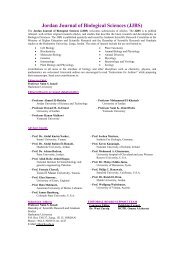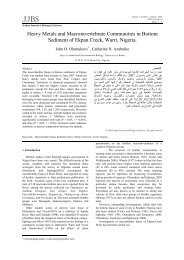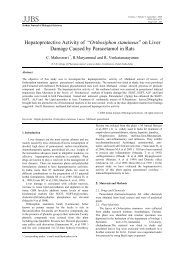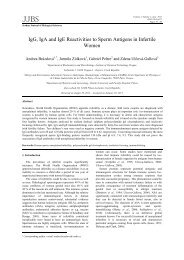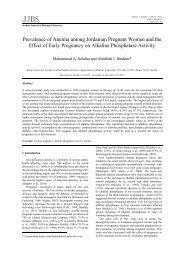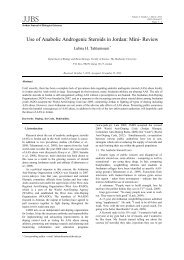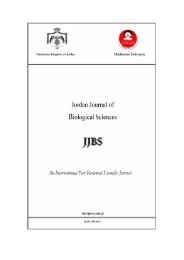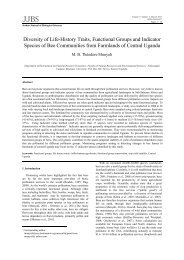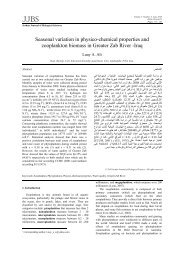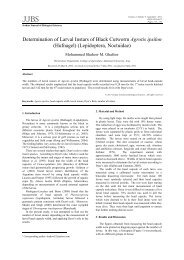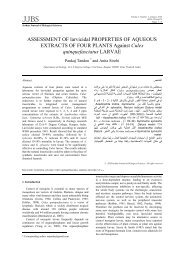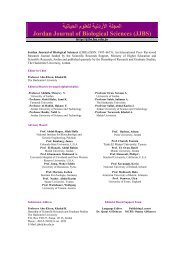A Fast and Sensitive Molecular Detection of Streptococcus mutans ...
A Fast and Sensitive Molecular Detection of Streptococcus mutans ...
A Fast and Sensitive Molecular Detection of Streptococcus mutans ...
Create successful ePaper yourself
Turn your PDF publications into a flip-book with our unique Google optimized e-Paper software.
138<br />
© 2008 Jordan Journal <strong>of</strong> Biological Sciences. All rights reserved - Volume 1, Number 3<br />
Figure 2: Agarose gel electrophoresis <strong>of</strong> PCR amplified products<br />
for 16s rDNA specific to <strong>Streptococcus</strong> genus for four plaque<br />
samples. The amplified b<strong>and</strong> is 1505 bp. Lane M; molecular<br />
weight marker (1K bp ladder). Lane 1: positive control (PCR<br />
amplified product from genomic DNA isolated from the bacterial<br />
species <strong>Streptococcus</strong> <strong>mutans</strong>), (Lanes 2 <strong>and</strong> 3: represents plaques<br />
from natural tooth, (Lanes 4 <strong>and</strong> 5): represents plaques from<br />
crown tooth. (Lanes 2 <strong>and</strong> 4): represents the supragingival plaque,<br />
(Lanes 3 <strong>and</strong> 5): represents the subgingival plaque. Lane 6:<br />
negative control.<br />
3.4. PCR detection <strong>of</strong> the presence <strong>of</strong> Actinomyces<br />
viscosus by using primer pair specific to these species<br />
PCR detection <strong>of</strong> the presence <strong>of</strong> species Actinomyces<br />
viscosus using primer pair specific for this species (Table<br />
1) resulted in an amplified product <strong>of</strong> 96 bp which was<br />
detected in all four samples (Fig. 4). All these samples<br />
were recorded negative <strong>of</strong> Actinomyces species by using<br />
the cultivation on CFAT medium.<br />
4. Discussion<br />
In this study four plaque samples, which belong to one<br />
person, were included in the study. The plaque samples,<br />
which were obtained from crown site, have zero count <strong>of</strong><br />
<strong>Streptococcus</strong> <strong>mutans</strong> <strong>and</strong> <strong>of</strong> Actinomyces viscosus.<br />
However, PCR methodology was able to positively detect<br />
<strong>Streptococcus</strong> <strong>mutans</strong> <strong>and</strong> Actinomyces viscosus in all<br />
these samples. Wade (2002) indicated that many bacteria<br />
escaped the conventional culture techniques for detection<br />
either because they are unproductive, or because there are<br />
not distinguishable from similar species by observable<br />
phenotypic characteristics. In this study, <strong>Streptococcus</strong><br />
<strong>mutans</strong> <strong>and</strong> Actinomyces viscosus were not detected in<br />
previous samples based on the conventional culture<br />
method. This could be attributable to their presence in low<br />
proportions in the samples, <strong>and</strong>/or the culture medium was<br />
not sensitive enough for the detection <strong>of</strong> the low levels <strong>of</strong><br />
those bacterial species. This confirms <strong>and</strong> proves that PCR<br />
is more sensitive than conventional culture method.<br />
The results <strong>of</strong> this study confirm the disadvantages <strong>of</strong><br />
conventional method such as poor specificity <strong>and</strong><br />
sensitivity; detection <strong>of</strong> only viable culturable bacteria -<br />
<strong>and</strong> that they are time consuming <strong>and</strong> laborious.<br />
Figure 3: PCR detection <strong>of</strong> the species <strong>Streptococcus</strong> <strong>mutans</strong> in<br />
four plaque samples. Lane M; molecular weight marker (100 bp<br />
ladder), Lane 1: positive control, (Lanes 2 <strong>and</strong> 3): represents<br />
plaque samples from natural tooth, (Lanes 4 <strong>and</strong> 5): represents<br />
plaque samples from crown tooth, (Lanes 2 <strong>and</strong> 4): represents<br />
supragingival plaque samples, (Lanes 3 <strong>and</strong> 5): represents<br />
subgingival plaque samples. The size <strong>of</strong> amplified product is 282<br />
bp. Lane 6: negative control.<br />
Figure 4: PCR detection <strong>of</strong> the species Actinomyces viscosus in<br />
four plaque samples. Lane M; molecular weight marker (100 bp<br />
ladder), (Lanes 1 <strong>and</strong> 2): represents plaque samples from natural<br />
tooth, (Lanes 3 <strong>and</strong> 4): represents plaque samples from crown<br />
tooth, (Lanes 1 <strong>and</strong> 3): represents supragingival plaque samples,<br />
(Lanes 2 <strong>and</strong> 4): represents subgingival plaque samples. The size<br />
<strong>of</strong> amplified product is 282 bp. Lane 5: negative control.<br />
On the other h<strong>and</strong>, PCR methodology provides a more<br />
sensitive mean <strong>of</strong> detection <strong>of</strong> putative bacterial species<br />
even non-culturable bacteria if compared with<br />
conventional culture techniques. Also it is able to detect<br />
low numbers <strong>of</strong> bacterial species, being quick <strong>and</strong><br />
relatively simple to perform. Moreover, a PCR assay has<br />
been found to be suitable for the specific detection <strong>and</strong><br />
identification <strong>of</strong> human cariogenic bacteria like<br />
<strong>Streptococcus</strong> <strong>mutans</strong> (Sato et al., 2003). This study<br />
detected both <strong>Streptococcus</strong> <strong>mutans</strong> <strong>and</strong> Actinomyces<br />
species to be the most serious human cariogenic bacteria.<br />
This research provides protocols that are potentially<br />
considered a cornerstone <strong>of</strong> the oral microbiological<br />
research that can be conducted in order to investigate the<br />
composition <strong>of</strong> dental plaque with many stressful factors,<br />
for instance, presence <strong>of</strong> dental materials.



